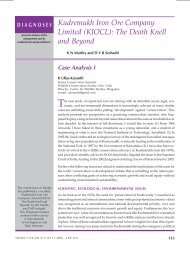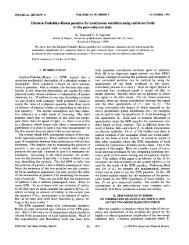Phase Transfer Catalysis - Publications of the IAS Fellows
Phase Transfer Catalysis - Publications of the IAS Fellows
Phase Transfer Catalysis - Publications of the IAS Fellows
Create successful ePaper yourself
Turn your PDF publications into a flip-book with our unique Google optimized e-Paper software.
eactor system, Stanley and Quinn (1987) reported that this<br />
intriguing benefit <strong>of</strong> <strong>the</strong> organic phase mass-transfer resistance<br />
does not really materialize and that catalytic effectiveness<br />
decreases when <strong>the</strong> film thickness increases. Thus,<br />
though conversion in <strong>the</strong> membrane reactor increased with<br />
membrane thickness because a thicker membrane gave higher<br />
active reactor volume, <strong>the</strong> effectiveness factor decreased with<br />
increasing mass-transfer resistance due to <strong>the</strong> thicker membranes<br />
(Figure 6). It should be noted that in this case <strong>the</strong><br />
hydrophobic membrane used was assumed to be free <strong>of</strong> any<br />
diffusional limitations (large pores compared to dimensions<br />
<strong>of</strong> diffusing reactants) with no selectivity toward any <strong>of</strong> <strong>the</strong><br />
species. Thus, under <strong>the</strong>se conditions, <strong>the</strong> membrane merely<br />
stabilizes <strong>the</strong> interface and is effectively a stagnant region <strong>of</strong><br />
organic liquid. The authors developed an exact analysis <strong>of</strong><br />
intramembrane diffusion and reaction similar to Evans and<br />
Palmer’s (1981), and studied <strong>the</strong> effect <strong>of</strong> Damkohler number,<br />
organic reaction equilibrium rate constant, reactant<br />
feed-rate ratio, flow rate <strong>of</strong> <strong>the</strong> organic phase, and <strong>the</strong> organic<br />
reaction reactivity on conversion. Assuming cocurrent<br />
plug flow in <strong>the</strong> channels, simple one-dimensional convection/reaction<br />
flow channel mass balances and membrane<br />
mass balances were set up. Ion-exchange equilibrium was assumed<br />
at <strong>the</strong> organic/aqueous interface (on <strong>the</strong> aqueous side<br />
<strong>of</strong> <strong>the</strong> membrane). The reader is referred to <strong>the</strong> original article<br />
for details <strong>of</strong> <strong>the</strong> complicated set <strong>of</strong> equations and a discussion<br />
<strong>of</strong> <strong>the</strong> solutions.<br />
Various o<strong>the</strong>r ways <strong>of</strong> characterizing <strong>the</strong> role <strong>of</strong> mass<br />
transfer in PTC systems have been reported. For example,<br />
based on <strong>the</strong> two-film <strong>the</strong>ory, Chen et al. (1991) derived algebraic<br />
expressions for <strong>the</strong> interphase flux <strong>of</strong> QY and QX.<br />
Nonlinear differential equations described <strong>the</strong> slow reaction<br />
in <strong>the</strong> organic phase, and coupled algebraic equations described<br />
<strong>the</strong> dissociation equilibria in <strong>the</strong> aqueous phase and<br />
<strong>the</strong> species mass balance. Model parameters were estimated<br />
dimensionless thickness, Da<br />
Figure 6. Effect <strong>of</strong> membrane thickness on RX conversion<br />
and catalytic effectiveness.<br />
Adapted from Stanley and Quinn (1987).<br />
from experimental data using a two-stage optimal parameter<br />
estimation scheme. Wu (1993) used a two film <strong>the</strong>ory to consider<br />
mass transfer <strong>of</strong> catalyst between two liquid phases and<br />
characterized <strong>the</strong> transfer <strong>of</strong> Q+X- from <strong>the</strong> organic phase<br />
to <strong>the</strong> aqueous phase and <strong>of</strong> Q+Y- from <strong>the</strong> aqueous to <strong>the</strong><br />
organic phase by defining<br />
If PTC in both phases is in extractive equilibrium and masstransfer<br />
resistances are neglected completely, <strong>the</strong>n t,!fQy and<br />
$Qx are each equal to 1. Assuming extractive equilibrium and<br />
complete dissociation <strong>of</strong> m and MX in <strong>the</strong> aqueous phase,<br />
Wu (1993) derived a set <strong>of</strong> balance equations that were solved<br />
by eliminating <strong>the</strong> time variable (phase plane modeling). The<br />
relevant rate equations are<br />
- GXO<br />
dt<br />
= k2cRXocQY~<br />
- dcQX<br />
d = klchfY~cQX~ - k- lcMXacQYa<br />
dt<br />
- dcQY<br />
d = klQYa(mQYcQYa - cQYo)<br />
dt<br />
(7)<br />
- klcMYacQXo + k- &4XacQYa (11)<br />
Overall mass balance equations can be written for <strong>the</strong> quaternary<br />
cation, and Y- and X- anions.<br />
&J = K(cQYo + cQXo) + KccQXa + 'QY) w2)<br />
Niy = vO( cQ& + c& - c~x~) + va(cy; + CQy) (13)<br />
Nix + I(&xO + qO = vo(cQXo + c~xo) + 6ccx; + cQXa)<br />
(141<br />
Dynamics for a slow phase-transfer reaction (pseudo-firstorder<br />
kinetics) and a mass-transfer controlled instantaneous<br />
reaction were studied. Wu (1996) modified <strong>the</strong> solution for a<br />
slow reaction by not assuming pseudo-first-order kinetics but<br />
making <strong>the</strong> pseudo-steady-state assumption for catalyst<br />
species (QY and QX) in both <strong>the</strong> aqueous and <strong>the</strong> organic<br />
phases. A complicated equation was derived for <strong>the</strong> concentration<br />
<strong>of</strong> RX, assuming <strong>the</strong> concentration <strong>of</strong> <strong>the</strong> PT catalyst<br />
to be much smaller than that <strong>of</strong> <strong>the</strong> reactant. Wu (1996) also<br />
derived an expression for <strong>the</strong> catalyst effectiveness, which is<br />
defined as <strong>the</strong> ratio <strong>of</strong> <strong>the</strong> actual reaction rate to that with all<br />
<strong>the</strong> catalyst present as QY, in terms <strong>of</strong> seven physically meaningful<br />
dimensionless parameters, including <strong>the</strong> Damkohler<br />
numbers that give <strong>the</strong> relative rates <strong>of</strong> <strong>the</strong> organic reaction<br />
AIChE Journal March 1998 Vol. 44, No. 3 623
















